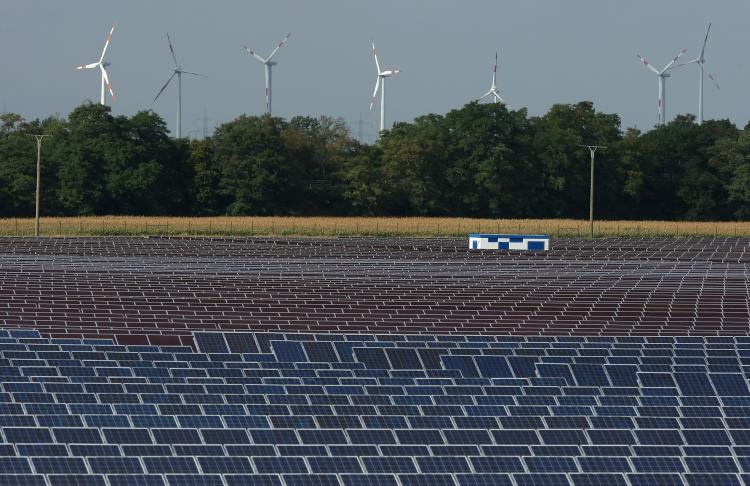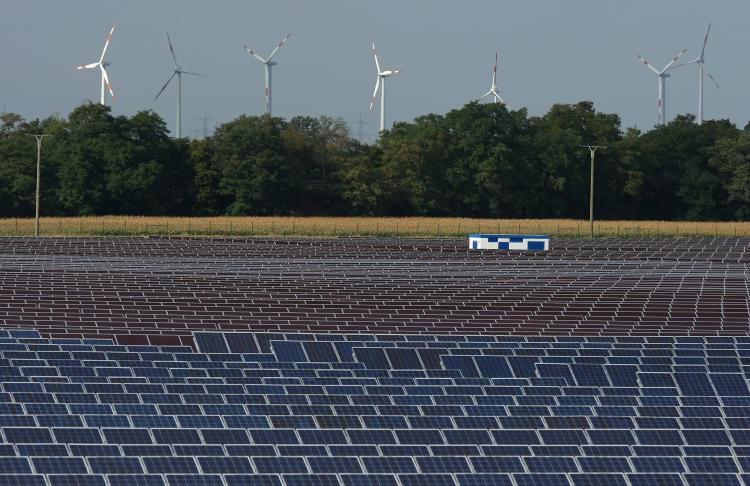WASHINGTON—Though it has received much hype, the global renewable energy industry is still in its infancy. But if green energy manufacturers can generate roughly more than $15 billion in investments by the end of 2012, the industry could achieve parity with traditional energy, according to a recent study.
In 2010, investments in renewable energy sources, including wind, solar, and ocean power, will soar to $5 billion.
The search for funds is on, and many companies now depend on private investments as the coffers of many governments dry up.
“As government’s share of funding declines, manufacturers and investors alike will increasingly depend on production economics, not global politics, to achieve high returns on invested capital,” according to a recent study on the business of renewable energy by Free Sky Research LLC.
Venture capitalists so far have stayed on the sidelines, as any return is not foreseeable and transparency is currently lacking. Fewer than 20 percent of venture capitalists are putting funds into renewable energy start-ups. Most funding for renewable energy ventures is from syndicated bank loans and other similar type of financing.
“While venture capitalists and IPOs [Initial Public Offerings] get most of the press, the renewable electricity manufacturing industry depends heavily on more mundane types of financing, including syndicated bank loans and large convertible debt issuances,” according to a recent Research and Markets press release. “The average listed solar manufacturer, for example, receives less than a quarter of its public financing from its IPO.”
Cheaper than Gas?
“A key advantage commonly overlooked with respect to energy alternatives such as wind, solar, and geothermal power is that there are no fuel costs, now or in the future,” researchers said in a 2009 energy policy report published by Elsevier.
Recent analysis of Texas utility Austin Energy’s annual report indicates that despite relatively modest gas prices, renewable energy is still a cheaper option for most. Austin saved $50 million for its customers over the past two years using alternative energy sources.
“Austin’s purchases of renewable energy in 2009 were still $5/MWh cheaper than gas, saving Austinites money even as natural gas prices were at historic lows. In 2008, when gas prices were higher before the recession, renewable energy was about $54/MWh cheaper,” according to an analysis posted on the Environmental Defense Fund blog.
The analysis generated quite a bit of discussion and controversy over the merit of renewable energy, but no matter how one slices it, renewable energy generation can be cheaper than traditional energy under most conditions.
The discussion led to further analysis, which was posted mid-April, changing the previous savings of $50 million for Austin customers to $10 million over the two-year period.
By using a different manner of deriving the data, the altered “scenario shows smaller but still substantial savings of almost $10 million dollars for Austinites over two years,” indicating that no method to derive cost-effectiveness is perfect, according to the revised post.
Austin has published its new energy code, which requires that all newly constructed homes and commercial buildings meet certain energy standards that will save energy costs. Renewable energy efforts allowed Austin to tap into the federal stimulus fund with an award of $7.5 million, which will be used to upgrade the energy efficiency of the municipal buildings.
Funding Renewable Energy Projects
According to a recent U.S. Department of Energy statement, “The Department’s Biomass Program has awarded nearly $718 million in Recovery Act funds to accelerate the commercialization of advanced biofuels and foster the growth of a sustainable U.S. bioindustry,”
Most recently, the U.S. Department of Energy announced funding of $18 million for a biofuel processing facility. In mid-April, the New York State Energy Research Development Authority and the Public Service Commission distributed $204 million for eight different renewable energy projects that should be in operation by 2015.
The Department of Energy not only awarded millions of dollars for projects, but also provided guarantees on company loans. In March, U.S. Secretary of Energy Steven Chu offered a loan guarantee of $117 million for a wind energy project in Hawaii, which will significantly decrease the need for traditional energy sources in the state. This project will create 200 jobs during construction and about 10 full-time jobs after construction.
“This investment will create jobs and cut our dependence on oil, while promoting America’s leadership in the global race for the clean energy industries of tomorrow,” said Chu in a press release.
Tax Credits for Homeowners
Tax credits for up to 30 percent of the cost of installation of renewable energy products in existing residential homes will expire at the end of 2010. The credit can also be taken for insulation jobs, new roofs that are metal or asphalt, non-solar water heaters, windows and doors, and certain heating or air conditioning systems, but cannot be used for rental or vacation properties.
The U.S. Department of Energy has published details about “Consumer Energy Tax Incentives,” funded under the American Recovery and Reinvestment Act, which can be found at energy.gov/taxbreaks.htm.
Besides federal tax incentives, there are utility or state rebates and tax incentives for energy-efficient products, vehicles, and homes.
“A tax credit is generally more valuable than an equivalent tax deduction because a tax credit reduces tax dollar-for-dollar, while a deduction only removes a percentage of the tax that is owed. Consumers can itemize purchases on their federal income tax form, which will lower the total amount of tax they owe the government,” according to the U.S. Department of Energy website.
In 2010, investments in renewable energy sources, including wind, solar, and ocean power, will soar to $5 billion.
The search for funds is on, and many companies now depend on private investments as the coffers of many governments dry up.
“As government’s share of funding declines, manufacturers and investors alike will increasingly depend on production economics, not global politics, to achieve high returns on invested capital,” according to a recent study on the business of renewable energy by Free Sky Research LLC.
Venture capitalists so far have stayed on the sidelines, as any return is not foreseeable and transparency is currently lacking. Fewer than 20 percent of venture capitalists are putting funds into renewable energy start-ups. Most funding for renewable energy ventures is from syndicated bank loans and other similar type of financing.
“While venture capitalists and IPOs [Initial Public Offerings] get most of the press, the renewable electricity manufacturing industry depends heavily on more mundane types of financing, including syndicated bank loans and large convertible debt issuances,” according to a recent Research and Markets press release. “The average listed solar manufacturer, for example, receives less than a quarter of its public financing from its IPO.”
Cheaper than Gas?
“A key advantage commonly overlooked with respect to energy alternatives such as wind, solar, and geothermal power is that there are no fuel costs, now or in the future,” researchers said in a 2009 energy policy report published by Elsevier.
Recent analysis of Texas utility Austin Energy’s annual report indicates that despite relatively modest gas prices, renewable energy is still a cheaper option for most. Austin saved $50 million for its customers over the past two years using alternative energy sources.
“Austin’s purchases of renewable energy in 2009 were still $5/MWh cheaper than gas, saving Austinites money even as natural gas prices were at historic lows. In 2008, when gas prices were higher before the recession, renewable energy was about $54/MWh cheaper,” according to an analysis posted on the Environmental Defense Fund blog.
The analysis generated quite a bit of discussion and controversy over the merit of renewable energy, but no matter how one slices it, renewable energy generation can be cheaper than traditional energy under most conditions.
The discussion led to further analysis, which was posted mid-April, changing the previous savings of $50 million for Austin customers to $10 million over the two-year period.
By using a different manner of deriving the data, the altered “scenario shows smaller but still substantial savings of almost $10 million dollars for Austinites over two years,” indicating that no method to derive cost-effectiveness is perfect, according to the revised post.
Austin has published its new energy code, which requires that all newly constructed homes and commercial buildings meet certain energy standards that will save energy costs. Renewable energy efforts allowed Austin to tap into the federal stimulus fund with an award of $7.5 million, which will be used to upgrade the energy efficiency of the municipal buildings.
Funding Renewable Energy Projects
According to a recent U.S. Department of Energy statement, “The Department’s Biomass Program has awarded nearly $718 million in Recovery Act funds to accelerate the commercialization of advanced biofuels and foster the growth of a sustainable U.S. bioindustry,”
Most recently, the U.S. Department of Energy announced funding of $18 million for a biofuel processing facility. In mid-April, the New York State Energy Research Development Authority and the Public Service Commission distributed $204 million for eight different renewable energy projects that should be in operation by 2015.
The Department of Energy not only awarded millions of dollars for projects, but also provided guarantees on company loans. In March, U.S. Secretary of Energy Steven Chu offered a loan guarantee of $117 million for a wind energy project in Hawaii, which will significantly decrease the need for traditional energy sources in the state. This project will create 200 jobs during construction and about 10 full-time jobs after construction.
“This investment will create jobs and cut our dependence on oil, while promoting America’s leadership in the global race for the clean energy industries of tomorrow,” said Chu in a press release.
Tax Credits for Homeowners
Tax credits for up to 30 percent of the cost of installation of renewable energy products in existing residential homes will expire at the end of 2010. The credit can also be taken for insulation jobs, new roofs that are metal or asphalt, non-solar water heaters, windows and doors, and certain heating or air conditioning systems, but cannot be used for rental or vacation properties.
The U.S. Department of Energy has published details about “Consumer Energy Tax Incentives,” funded under the American Recovery and Reinvestment Act, which can be found at energy.gov/taxbreaks.htm.
Besides federal tax incentives, there are utility or state rebates and tax incentives for energy-efficient products, vehicles, and homes.
“A tax credit is generally more valuable than an equivalent tax deduction because a tax credit reduces tax dollar-for-dollar, while a deduction only removes a percentage of the tax that is owed. Consumers can itemize purchases on their federal income tax form, which will lower the total amount of tax they owe the government,” according to the U.S. Department of Energy website.





